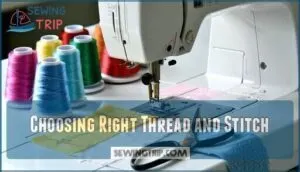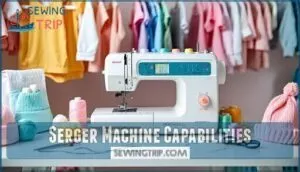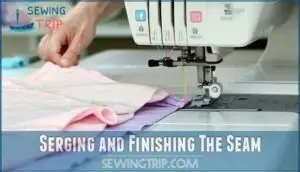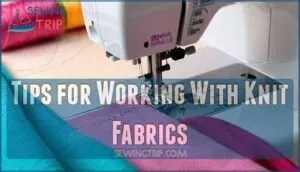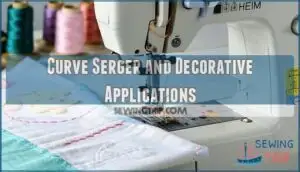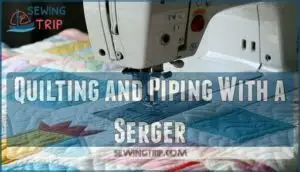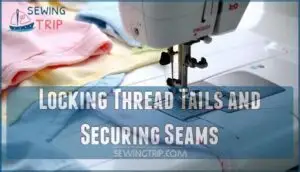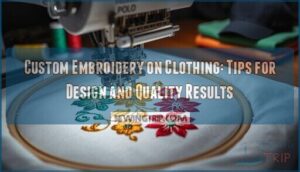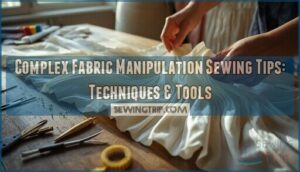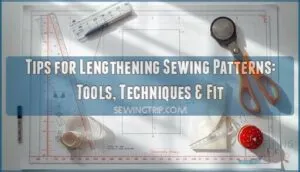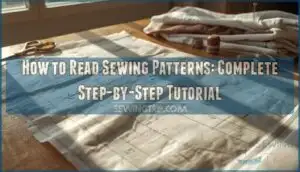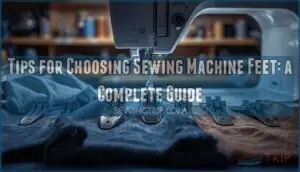This site is supported by our readers. We may earn a commission, at no cost to you, if you purchase through links.
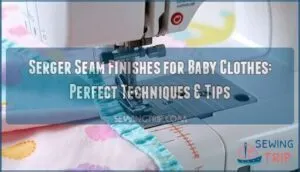
Your serger trims, sews, and finishes in one pass – perfect for stretchy knits and soft cottons.
Use a 4-thread overlock for maximum strength on stress points like shoulders and crotches, while 3-thread works great for side seams.
The overlocking stitch prevents fraying through countless washes, and you’ll love how it eliminates bulk that regular seams create.
Choose soft polyester thread that won’t break down in frequent washing.
The secret lies in matching your stitch width to fabric weight and knowing when to switch techniques for different garment areas.
Table Of Contents
Key Takeaways
- You’ll get professional results using a 4-thread overlock for high-stress areas like shoulders and crotch seams, while 3-thread works perfectly for side seams that need less reinforcement.
- Choose soft polyester thread over cotton since it won’t break down through frequent washing and provides superior strength for baby clothes that face constant wear.
- Match your stitch width to fabric weight and adjust techniques for different garment sections – this prevents puckering on delicate fabrics while ensuring durability.
- Your serger trims, sews, and finishes edges simultaneously creating bulk-free seams that protect sensitive skin from rough edges while preventing fraying through countless wash cycles.
Baby Seam Finish Techniques
You’ll discover that baby seam finishes aren’t just for actual babies—they’re a fancy French technique that makes your delicate fabrics look professionally finished without a serger.
This method works magic on silk, chiffon, and other tricky materials that would normally fray like crazy, giving you that high-end boutique look right from your sewing room.
History of Baby Seam Finish
The baby seam finish traces its roots to France’s Haute Couture tradition, gaining widespread popularity during the 1920s and 1930s.
This sophisticated technique was crafted specifically for delicate fabrics like silk chiffon, where traditional seam finishes would show through or damage the material.
Unlike today’s serger-dependent methods, these hand-sewn finishes required exceptional skill and patience.
Modern baby clothing construction rarely uses this time-intensive approach, though luxury houses still employ it for heirloom pieces requiring durable seams baby garments deserve.
This finish is especially useful on sheer and semi-transparent fabrics, making it a valuable technique for working with delicate fabrics.
Ideal Fabrics for Baby Seam Finish
You’ll want to choose fabrics that feel like butter on baby’s skin.
Cotton voile and silk chiffon work beautifully for baby clothes sewing because they’re lightweight and breathable.
These delicate fabrics won’t irritate sensitive skin, while their fabric weight makes serger seam finish techniques shine.
Sheer fabrics like muslin create soft seams baby clothes need, and your baby clothing fabric choice directly impacts comfort and durability.
Many parents prefer hypoallergenic natural fabrics to avoid irritating a baby’s sensitive skin, opting for materials that provide a gentle touch and breathable properties, which are essential for baby’s skin.
Construction and Seam Allowance
Setting up proper seam allowances makes all the difference in baby clothes construction.
You’ll need a generous 5/8" seam allowance width for baby seam finish techniques, giving you room to work with delicate fabrics.
Pay attention to fabric grain direction when cutting – it affects how your knit fabric stretch behaves during serging.
Pattern adjustments might be necessary for different seam type selections, especially when switching from regular serger seam finish to baby seam finish methods.
Choosing Right Thread and Stitch
You’ll want to choose the right thread and stitch combo to make baby clothes that actually last through countless washes and wiggly adventures.
Smart thread and stitch choices mean fewer blowouts, stronger seams, and clothes that stay cute even after baby’s messiest days, which ultimately leads to stronger seams.
Benefits of Polyester Thread
Polyester thread delivers unbeatable Thread Strength for baby clothes, outlasting cotton alternatives that fray after just a few washes.
Your serger seam strength stays intact through countless diaper blowouts and spit-up incidents.
This baby clothing thread offers superior Wash Durability and Color Retention, maintaining vibrant hues while providing excellent Cost Effectiveness.
Among serger thread types, polyester guarantees reliable Seam Longevity for garments meant to survive active little ones.
Selecting Stitches for Stretchy Fabrics
Now that you’ve picked a strong thread, let’s talk stitches!
Stretch Stitch Types, like zigzag or lightning bolt, keep your knit fabric serger seams comfy and safe.
Try different serger stitch types and play with serger stitch tension and differential feed settings to beat Seam Gaping Issues.
Understanding various knit patterns can further enhance your fabric choices.
Exploring Knit Stitch Options means your baby clothes will always have cozy, comfortable baby seams, with a focus on Seam Gaping Issues.
Importance of Thread Quality
Choosing quality threads isn’t just about color matching—it’s your secret weapon for creating baby clothes that’ll survive countless wash cycles.
Thread durability directly impacts seam strength, especially when your serger’s working overtime on stretchy fabrics.
Poor-quality threads break down quickly, creating weak spots that’ll have you doing constant repairs.
Polyester threads offer superior wash resistance and fabric compatibility compared to cotton alternatives, keeping those baby clothing seams intact through endless diaper blowouts and spit-up incidents.
To guarantee longevity, consider serger thread options.
Serger Machine Capabilities
Your serger isn’t just an edge-finishing machine—it’s a powerhouse that can handle multiple stitch types to create professional-looking baby clothes.
Understanding your serger’s different capabilities will help you choose the right stitch for each part of your project, from sturdy seams to delicate hems.
Types of Overlock Stitches
Your serger machine offers several overlock stitch types, each serving specific purposes in baby clothes construction.
The 4-thread overlock provides maximum overlock stitch strength for high-stress seams, while 3-thread creates moderate security with less stitch bulk comparison.
For delicate fabrics, 2-thread overlock delivers lightweight fabric fray prevention.
A popular choice is the versatile overlock machine, which offers a range of features.
These serger stitch types give you decorative edge options and specialty stitch uses perfect for various baby garment needs.
Rolled Hem and Flatlock Stitches
For baby clothes, rolled hem uses include finishing edges on lightweight fabrics like cotton voile with 1/8" width finishes.
Flatlock durability shines in stretchy knits, creating bulk-free seams perfect for sensitive skin, and decorative flatlock adds visual appeal while maintaining comfort.
Hem fabric choice matters – rolled hems work best on thin materials, while flatlock excels on knits, and proper stitch tension guarantees professional serger seam finishes every time.
Blind Hem and Picot Edge Stitches
Through expert serger seam finishes for baby clothes, you’ll master blind hem and picot edge stitches that create professional results.
Blind hem uses nearly invisible stitching for polished hems, while picot edge fabrics get decorative scalloped edges.
These techniques prevent stitch visibility issues and avoid bulky seams that irritate delicate skin.
A serger, also known as an overlock machine, provides durable, fray-free seams, enhancing garment longevity.
Here’s what makes these stitches perfect for baby garments:
- Gentle comfort – Soft edges won’t scratch or irritate sensitive baby skin
- Stretchy flexibility – Moves with active babies without binding or breaking
- Professional appearance – Creates boutique-quality finishes at home
- Durability boost – Prevents fraying through countless wash cycles
- Decorative charm – Adds elegant details to special occasion outfits
Sewing Serged Seams Step by Step
You’re about to master the art of creating professional seams that’ll keep those tiny outfits looking great wash after wash.
Let’s walk through the exact steps that’ll turn your serger into a baby clothes powerhouse.
Serging and Finishing The Seam
Perfect timing matters when serging baby clothes seams. You’ll guide fabric through at a steady speed while maintaining proper stitch tension for seam durability.
Watch fabric compatibility closely – delicate materials need gentler handling than sturdy cottons. A serger can create durable five thread safety stitches suitable for heavy fabrics.
| Step | Action | Result |
|---|---|---|
| Feed fabric | Guide layers smoothly through | Clean, even stitches |
| Maintain tension | Keep fabric taut, not stretched | Prevents puckering |
| Trim excess | Cut close to serger edge finishes | Reduces bulk |
Your serger techniques for baby clothes should prioritize edge fraying prevention. The machine’s knife trims while stitching, creating professional baby seam finish results. This bulk reduction keeps seams comfortable against sensitive skin while ensuring durability through countless washes.
The key to successful serging is maintaining a steady speed and proper tension. By following these guidelines and using your serger correctly, you can create beautiful, durable seams for baby clothes. Proper stitch tension and fabric compatibility are crucial for a professional finish.
Tips for Working With Knit Fabrics
When working with knit fabrics, you’ll want to handle their stretchy nature with care.
Knit fabric stretch requires a ballpoint needle to slip between fibers rather than piercing them.
Adjust your differential feed to 1.5 or higher to prevent wavy edges.
Fine-tune tension adjustments gradually – knits need less tension than wovens.
For stabilizing knits, use a walking foot or tissue paper underneath.
These serger techniques baby clothes benefit from include using polyester thread for flexibility.
Your baby clothing serging projects will turn out beautifully with these knit fabrics tips.
Advanced Serger Techniques
You’ve mastered the basics, and now it’s time to discover your serger’s full potential with advanced techniques that’ll make your baby clothes look professionally made.
These pro-level skills will help you create curved seams that lay perfectly flat, secure thread tails that won’t come undone after countless washes.
They will also enable you to add decorative touches that’ll make other parents wonder where you bought such beautiful clothes.
Curve Serger and Decorative Applications
Curves in baby clothing serging require steady hands and smart adjustments.
You’ll slow down your serger and gently guide fabric through armholes and necklines without stretching.
Pre-trim curves for smoother results, then use decorative threads like Sulky Poly Deco in loopers for colorful edges.
Try rolled hems or flatlocks with contrasting thread – they transform basic seams into playful accents on baby apparel sewing projects while staying soft against delicate skin.
Regular maintenance helps guarantee flawless serger seam finishes for delicate skin.
Quilting and Piping With a Serger
Your serger transforms into a quilting powerhouse for baby apparel sewing projects.
Use quilt piecing techniques to join fabric layers quickly and accurately. The decorative seams create exposed, professional finishes that add visual interest.
For piping application, your serger simplifies the process beautifully. Try the blanket stitch setting for finishing fleece edges on baby blankets using serger techniques that save time.
Locking Thread Tails and Securing Seams
You’ll sleep better knowing your baby’s clothes won’t fall apart after the first wash.
Since sergers can’t reverse, you need smart thread tail methods to prevent unraveling.
Stitch over tails at seam starts and ends for seam durability.
For securing curved seams, use this pro tip: leave longer tails, then weave them through serger threads using a needle.
This professional finish guarantees your serger settings create lasting baby clothes that withstand countless adventures.
Frequently Asked Questions (FAQs)
What is a seam finish on a serger?
Absolutely game-changing!
Your serger’s seam finish wraps fabric edges in thread while cutting away excess material.
It prevents fraying, creates stretchy seams perfect for knits, and gives you professional-looking results every time.
How do you sew open seams on a serger?
You’ll need to adjust your serger technique since standard sergers create enclosed seams, not open ones.
Instead, use a regular sewing machine for open seams, then finish raw edges separately with your serger’s overlock stitch.
What is a serged seam?
Think of it as your fabric’s best friend – a serged seam uses multiple threads to simultaneously stitch and finish raw edges.
You’ll get stronger, stretchier seams that won’t fray, making them perfect for baby clothes that need durability.
How do you start and finish a serged seam?
Starting a serged seam is simple – just align your fabric edges and begin stitching.
You don’t need to backstitch since sergers lock automatically.
To finish, stitch off the fabric edge, then secure those thread tails by threading them through your seam using a tapestry needle.
Can a serger sew and neaten a seam at the same time?
Like a skilled multitasker, yes! You’ll love this two-in-one magic. Your serger simultaneously creates strong seams while trimming and finishing raw edges. It’s the ultimate time-saver for baby clothes.
Do you need a seam finish?
You’ll want seam finishes for baby clothes that’ll see tons of washing! Without them, edges fray and seams fall apart quickly. Sergers handle this beautifully by stitching and finishing simultaneously.
How to baby seam?
Baby seams aren’t just fairy tales—they’re real couture magic.
You’ll sew print sides together, stitch 3/8" from edge, fold leaving stitching visible, then stitch 1/8" from fold.
Trim close, fold again, stitch 1/8" from new edge, and that’s when you can say Voilà!
What is the best serger stitch for seams?
The 4-thread overlock stitch works best for baby clothes seams.
You’ll get strong, durable seams that stretch with knit fabrics while finishing raw edges simultaneously.
It’s perfect for those tiny garments that need serious staying power.
What tension settings work best for baby clothes?
Finding the sweet spot for tension settings is like tuning a guitar—it takes practice to get perfect harmony.
Start with balanced medium tension on all threads, then test-sew scraps of your baby fabric.
You’ll need slightly looser tension for stretchy knits and tighter for wovens to prevent puckering.
How do you prevent fabric puckering while serging?
Check your thread tension first – loose tension causes puckering on delicate fabrics.
Use a ballpoint needle for knits and reduce presser foot pressure.
Test stitch on scraps, then guide fabric gently without pulling or pushing through the machine, ensuring complete concepts are followed for better results, and maintaining proper handling techniques.
Conclusion
Nobody expects tiny humans to be fashion critics, but they’ll definitely judge your serger seam finishes for baby clothes.
Mastering these techniques is crucial, as it will allow you to create garments that survive countless wash cycles while keeping delicate skin happy.
Your 4-thread overlock will handle stress points like a champion, while 3-thread finishes breeze through side seams.
Remember: using soft polyester thread, proper stitch width, and matching technique to fabric weight is essential to achieve professional-quality results.
Soon you’ll be creating professional-quality baby clothes that are both durable and gentle.
- https://www.craftsy.com/post/sewing-with-a-serger/
- https://windsorpeak.com/vbulletin/showthread.php?p=3663520
- https://siemachtsewingblog.com/2022/05/serger-hems-for-thin-knit-fabrics/
- https://overtheedge.blog/serging-pants-with-a-5-thread-safety-stitch/
- https://www.made-by-rae.com/blog/2013/06/super-seams

